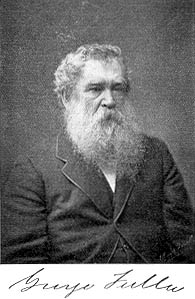Deerfield had statesmen as well as soldiers. May 1, 1780, the town met to consider the new Constitution of Massachusetts the clerk read the instrument paragraph by paragraph with pauses between.” After due discussion, a committee was chosen to “peruse the Constitution . . . and make such objections to it as they think ought to be made.” Three town-meetings were held, the committee reported, and finally a vote was passed “not to accept the third Article in the Declaration of Rights,” and that a candidate for governor must “Declare himself of the Protestant Religion” instead of “Christian Religion.” The term of eight years instead of fifteen was voted as the time when the Constitution should be revised. With these changes, our civic wisdom approved of this important State paper.
George Fuller
1822-1884.
Deerfield did her full duty in furnishing her quota of men and supplies through the war. Occasionally, in the later years of the struggle, the Tories temporarily obstructed the necessary town legislation. Some of these soon found themselves behind the bars, and others in enforced silence under penalty of like restraint. The minister, Mr. Ashley, who had been firm in his loyalty, died in 178o, and the Tories lost one of their strongest supports: Not until 1787 could the town unite upon his successor, when Rev. John Taylor was ordained. The uprising called Shays’ Rebellion did much to harmonize the warring factions, as all united to put it down. Three companies, under Captains Joseph Stebbins, Samuel Childs and Thomas W. Dickinson, were sent to the field of action.
From this time, harmony prevailed, and the career of the town was that of an industrious, hard-working, prosperous, intellectual people. Libraries and literary societies were established, which are still flourishing. Deerfield Academy was founded in 1797, and endowed largely through the liberality of the citizens. Its influence was felt for generations, as its pupils from far and wide were scions of leading families. Among its faculty and graduates may be named men of national reputation, in the scientific, the historical, the ecclesiastical, the military, the artistic and the industrial world.
|


